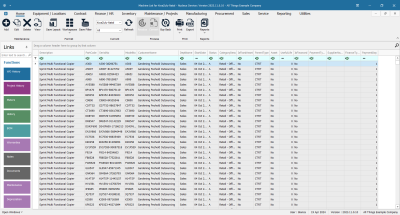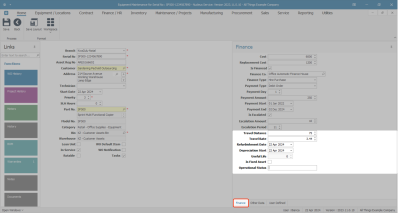We are currently updating our site; thank you for your patience.
Equipment
Assets - Add - Finance Details
Once the customer asset details have been added, you can follow the process below to add the customer asset finance details.
Asset Listing Screen
Ribbon Select Equipment and Locations > Assets
- The Machine Listing screen will be displayed.
Your employee user record should be linked to a default site. In this case, the site will auto populate with this default, otherwise the site must be manually selected.
Another site can be selected, if required, and if you have the security rights to access the site.
If All Sites displays here, then you do not have a default site configured on your user record, and need to select the required site.
Follow the process to add the customer asset details.
- Once the required details have been added, move across to the Finance frame.
Add Finance Frame Details
- Complete the finance details, as applicable.
- Cost: Either type in or use the arrow indicators to enter the cost of the customer machine. This is the current value of the customer machine.
- Replacement Cost: Either type in or use the arrow indicators to enter the replacement cost of the customer machine. This is the amount of money required to replace whatever is damaged or destroyed at today's cost.
- Is Financed: Click on this check box if this customer machine is financed by a finance house.
- Finance Co: Click on the drop-down arrow and select the finance company supplying finance for this machine, if applicable.
- Finance Type: Click on the drop-down arrow and select the finance type e.g. Hire Purchase, Lease Agreement, Rental Agreement.
- Payment Type: Click on the drop-down arrow and select the payment type e.g. Debit Order, Cheque, Bank Transfer, that is used to pay the finance house monthly.
- Payment Day: Either type in or use the arrow indicators to enter the day of the month that this payment will be made.
- Payment Amount: Either type in or use the arrow indicators to enter the payment amount that is to be paid monthly.
- Payment Start: Either type in or click on the drop-down arrow and use the calendar function to select the payment start date.
- Payment End: Either type in or click on the drop-down arrow and use the calendar function to select the payment end date.
- Is Escalated: Click on this check box if this payment amount is to be escalated after a period.
- Escalation Amount: Either type in or use the arrow indicators to enter the escalation amount.
- Escalation Period: Either type in or use the arrow indicators to enter the time after which this payment amount will be escalated.
- Travel Distance: Type in the total travel distance in kilometres, if you want the system to include travel on all call invoices raised.
- Travel Rate: Type in the travel rate if using Travel Distance.
- Refurbishment Date: Set the date at which this asset should be due for refurbishment, if applicable.
- Depreciation Start: Set the date from which this item will start depreciating.
- Useful Life: This is the estimated lifespan of a depreciable item - how many years it is likely to remain in service. This is important from an accounting perspective, where the usefulness of an asset is calculated before it gets written off, e.g. 5 years. Type in the number of months that the asset will be in condition before it is considered a write off. This field is affected by depreciation if it is enabled.As this is a customer asset, this field does not apply.
- Is Fixed Asset: As this is a customer asset, this check box should remain un-ticked. This flag is only ever used by the system when converting a serialised stock item to an internal asset.
- Operational Status: Here you can add information or comments about anything related to this customer asset e.g. machine passed Useful Life, or may be stripped for parts or may still be useful for short term loan out. This function provides information about the suitability of the asset for operation. Type in whether the asset is operational or not and why, if required.
Save Customer Asset
- When you have finished updating the customer asset details and finance details, you can
- Either follow the processes to:
- Add the asset Other Data and
- Add the asset User Defined fields, if required,
- Or
- Click on Save.
- You will return to the Machine List for [] screen.
- You will be able to view the added customer asset in the data grid.
MNU.007.043





